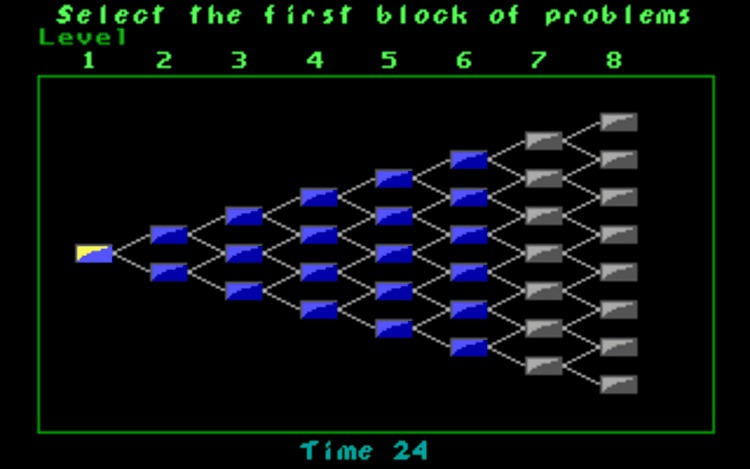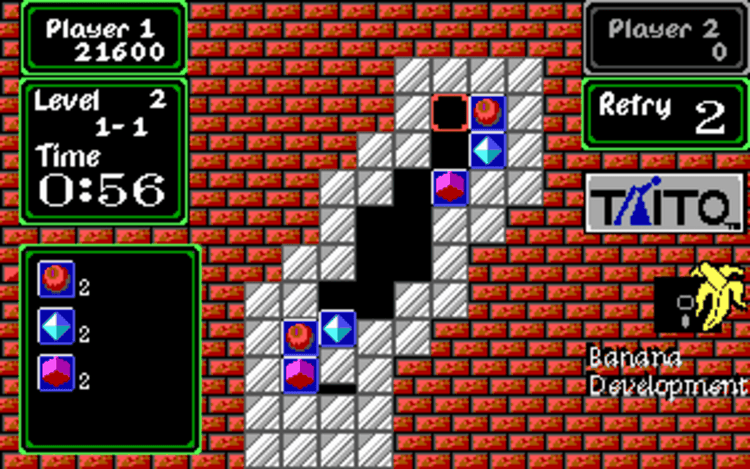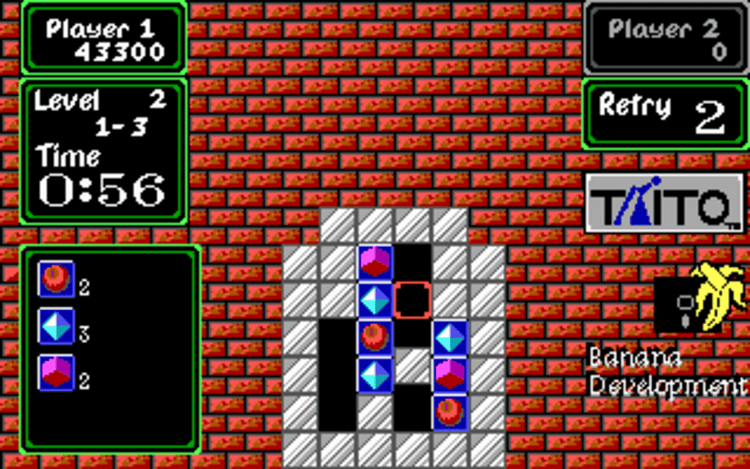
Puzznic is a classic puzzle game published by Taito that asks you to slide colored blocks together before gravity or the ticking timer wins. The elegant rule set recalls the careful planning of Sokoban and the kinetic satisfaction of Pipe Mania, yet the falling-block twist gives this title a personality all its own. Whether you play for a quick mental stretch or settle into a lengthy session, Puzznic’s clever design, catchy music, and escalating challenges make it an ideal way to enjoy timeless brain-teasing fun online or off.
When Taito migrated Puzznic from busy arcade halls to DOS computers, the publisher showcased how clever ideas, not pixel counts, keep a game vibrant across eras. The rules are disarmingly modest: slide patterned blocks along fixed rails, bring matching symbols together, and clear the board before the timer drains. Because every move obeys gravity, each stage behaves like a miniature physics conundrum. That emphasis on thought over speed is why the challenge feels as inviting to new players today as it did to floppy-disk owners decades ago.
Each board begins as a static mosaic. Your first nudge sets an elegant chain: unsupported tiles drop, collisions push neighbors, and unexpected pathways open or close in a blink. One careless slide can strand a vital block in a corner where reunion is impossible, yet recovery is painless; a single key-press restarts the puzzle immediately. This gentle loop of observing, imagining, acting, and learning turns five-minute breaks into hour-long marathons without the player noticing.
Puzznic’s instruction card could fit on a postcard: blocks move sideways, gravity handles the vertical, identical icons vanish, and a countdown limits hesitation. From that lean toolkit emerges surprising depth. Seasoned devotees orchestrate cascades where a falling tile shoves another mid-air, build makeshift bridges from mismatched blocks, or deliberately keep the field cluttered until the final seconds for maximum points. Designers still cite the title as proof that emergent play can blossom from the tightest constraints.
Sight and sound reinforce the mechanics while staying out of the way. Clean pixel symbols remain readable even on small screens, chip-tune loops lend urgency without distraction, and each successful match rings with a crisp chime that both celebrates and instructs. The presentation recalls fellow classics such as Sokoban and Pipe Mania, yet the ever-present pull of gravity gifts Puzznic a rhythm all its own—equal parts deliberate strategy and spontaneous delight.
Logic-first design translates effortlessly to modern browsers. Loading Puzznic now requires no installation or special plug-ins—open a page and play free of charge. Touch controls mirror the original arrow-key and mouse inputs, so sliding a tile with a fingertip on a phone feels as precise as nudging it with a keyboard on a desktop. Performance stays flawless across devices, letting you solve a handful of puzzles on a commute and resume later on a laptop without missing a beat.
The faithfully preserved difficulty curve remains a highlight. Early layouts introduce gravity’s quirks gently, while later boards resemble three-dimensional chess problems demanding impeccable sequencing. Instant restarts turn every misstep into an instructive moment rather than a setback. Whether you chase record times, hunt personal best scores, or simply savor quiet mental exercise, the online incarnation adapts to your chosen pace.
Puzznic contains no cut-scenes or dialogue, yet it radiates personality through nuance. Background palettes shift every few stages, triumphant jingles grow more elaborate as challenges intensify, and the ticking timer becomes an invisible antagonist urging decisive action. Many players weave their own myths—sorting jewels in a cosmic workshop, perhaps, or rearranging data blocks inside a whimsical computer core. By leaving narrative blank spaces, the game invites imagination rather than dictates it.
The approach aligns Puzznic with minimalist giants like Sokoban while standing apart through its dynamic physics. Where Sokoban emphasizes deliberate pushing, Puzznic blends foresight with sudden cascades, crafting a distinctive ebb and flow that few imitators match.
Longevity arises from the title’s ability to satisfy multiple play styles. Newcomers conquer early boards on intuition alone, while experts spend hours perfecting sequences that clear an entire screen in seconds. Speedrunners value the deterministic physics that reward pixel-perfect inputs, educators recommend the game to sharpen spatial reasoning, and casual fans appreciate its low-pressure presentation. Few experiences bridge such diverse audiences without losing clarity.
Contemporary releases often lean on unlock trees, daily quests, or social hooks. Puzznic predates those conventions and instead trusts curiosity, offering every mechanic from the outset and challenging players to improve through practice. That restraint feels refreshing even in an age of endless progression systems, reminding developers that depth often grows from simplicity.
The physical interface remains delightfully minimal: press or tap to grip a tile, move horizontally to steer, release to drop, and use a single reset key when time expires. These gestures become instinctive within minutes, freeing concentration for forward thinking and creative risk. Online leaderboards and fan-made challenge maps further demonstrate the concept’s flexibility. Because the core logic is so transparent, enthusiasts can craft new layouts that feel entirely official, extending replay value indefinitely while respecting the spirit of the original design.
Puzznic’s influence reaches far beyond its own stage list. Block-arranging favorites like Tetris Attack and countless modern match-three apps borrow the idea that a compact rule set can yield vast, emergent strategy. Academic research on game-based learning cites Puzznic for teaching planning horizons, since success demands visualizing gravity’s consequences several moves ahead. In short, a modest DOS release quietly shaped the vocabulary of interactive design.
All told, Taito’s compact masterpiece stands as a pillar of the puzzle genre—an elegant dialogue between human reasoning and digital physics that anyone can join at any moment.
All codes used in this game are publicly available, and Puzznic remains the property of its original authors.
Share game
Share game




Share game